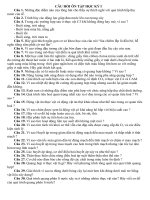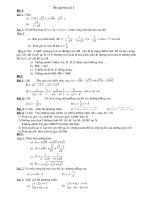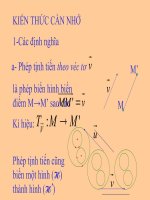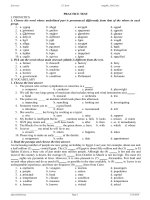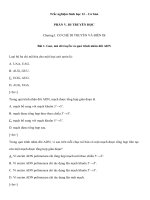Magic clusters on group IV surfaces 1
Bạn đang xem bản rút gọn của tài liệu. Xem và tải ngay bản đầy đủ của tài liệu tại đây (157.14 KB, 21 trang )
C
C
H
H
A
A
P
P
T
T
E
E
R
R
1
1
17
C
C
h
h
a
a
p
p
t
t
e
e
r
r
1
1
:
:
I
I
n
n
t
t
r
r
o
o
d
d
u
u
c
c
t
t
i
i
o
o
n
n
1.1 Introduction
Silicon (Si) and Silicon Carbide (SiC) are studied as the primary substrate
materials in this work. As the incumbent raw material in the micro-electronics industry,
the study of Si surfaces remains important, especially with the growing interest in the use
of mono-dispersed particles in the fabrication of substrate supported nanostructures.
Si(111) is the substrate of choice because of the presence of faulted/unfaulted halves of
the (7x7) reconstruction which possess available dangling bonds which in turn can
function as adsorption sites in promoting the self assembly of ordered nano particles. SiC
on the other hand is fast gaining recognition as a substrate material for electronic device
applications in areas where common silicon technology finds limitations. Due to its
unique properties such as wide band gap, high thermal conductivity and high breakdown
field strength, SiC based semiconductors electronic devices are presently being
developed for use in high-temperature, high power and high radiation conditions under
which conventional semiconductors cannot adequately perform [1-4]. In particular, we
focus on the 6H-SiC(0001) substrate which exhibits a wide range of surface
reconstructions and is also one of the more commonly used substrates [5-6].
C
C
H
H
A
A
P
P
T
T
E
E
R
R
1
1
18
In this work, we focus on the formation of low dimensional structures on these
substrates as the electronics industry has always been driven by the pursuit of faster and
more efficient devices via reduction in device dimensions. Examples of typical low
dimensional structures used in electronic applications include Quantum Dot Light
Emission, Single Electron Transistors and Quantum Computing Arrays [7-8]. In
particular, the advancement of silicon quantum dot nanostructures in solar photovoltaics
is of significant interest due to the urgency in developing clean energy alternatives [9-10].
Amorphous silicon is currently used to fabricate solar cells, but has always been plagued
by material degradation as prolonged illumination introduces defects which decrease the
solar cell efficiency [11-12]. In this respect, nano-crystalline silicon is much more stable
and has a broader absorption range in the visible part of the solar radiation [13-14].
Furthermore the optical properties could be tuned by affecting the band gap via changing
the size of the Si nano-crystals [15]. Hence the challenge is to be able to manufacture
semiconductor structures with greatly reduced sizes (in the regime of nanometers) on Si
and SiC surfaces controllably and reproducibly.
As the properties derived from these nano-structures are directly dependent on
feature size, shape, distribution as well as interface sharpness, it would therefore be
important to be able to re-produce these attributes with a high degree of uniformity.
However current top down methodologies such as optical lithography have encountered
limitations in feature size reduction due to radiation wavelength [16-17] while bottom up
techniques such as quantum dot formation via strain induced MBE thin film growth and
SAMs (self-assembled mono-layers) have struggled to generate particles with narrow size
C
C
H
H
A
A
P
P
T
T
E
E
R
R
1
1
19
distribution [18-21]. The key question therefore is whether we can deliberately prepare
and assemble specific sizes of materials such as metals/semiconductors on supporting Si
and SiC surfaces.
It is well known that small atomic clusters exhibit unique size-dependent physical
and chemical properties that differ from those of bulk materials [1] and maybe utilized to
form the desired nano-structure architecture. Hence there have been much experimental
and theoretical interest on atomic clusters, however most of the work was focused on
freestanding clusters [22] which do not address the issues in the formation of substrate
supported nano-structures. Interestingly the solution may lie in a unique phase of atomic
clusters termed as “magic clusters”. Magic clusters have been found to exist in a specific
size and structure consisting of a “magic” number of atoms exhibiting closed shell
structures leading to enhanced local stability [23]. This in turn leads to a high degree of
uniformity in physical, chemical and electronic properties being retained by magic cluster
species. Thus, the ability to fabricate substrate supported magic clusters, would address
the challenges related to fabrication of atomic structures and presents a progressive
platform for device miniaturization.
In fact, a considerable number of work [24-29] on magic clusters of various
material systems have been reported in a bid to create well ordered mono-dispersed nano-
structures for potential applications in micro-electronics, magnetic data storage and
atomically precise manufacturing [30-32]. These studies range from homogeneous
metallic systems (e.g. Ag/Ag(100) and Pt/Pt(110)[28-29]) to semiconducting systems (e.g.
C
C
H
H
A
A
P
P
T
T
E
E
R
R
1
1
20
Si/Si(111) and Si/SiC [33-36]) as well as heterogeneous systems comprising of mixed
metal/semi-conducting materials (e.g. In/Si(001) and Ga, In, Ag, Mn, Pb, Co-Si/Si(111)
[37-41]).
However there is still a bereft of studies concerning the origin and formation,
atomic structure, adsorption and diffusion characteristics, physical and electronic
properties of magic clusters. We therefore contribute to this area by studying the physical
and electronic properties of Si and binary magic clusters in terms of their size distribution,
chemical information, formation and transport behaviour on Si surfaces such as Si(111)
and SiC(0001) substrates as outlined in the following 3 Research Objectives.
C
C
H
H
A
A
P
P
T
T
E
E
R
R
1
1
21
1.2 Research Objectives
(I) Si Magic Clusters on 6H-SiC(0001)
One of the primary issues is to be able to prepare well ordered substrate surfaces
on which we can grow magic clusters. Hence we first study SiC surfaces in order to be
able to produce high quality surface templates repeatedly. 6H-SiC(0001) exhibits several
surface reconstructions ranging from (3x3), (√3x√3), (5x5), (2√3x2√13), (6x6) and
(6√3x6√3)R30° as shown by various techniques [5-6]. In this work, we report new STM
and XPS data that revealed the formation of an ordered (6x6) arrangement of Si clusters
(diameter~14.3±0.5Å) [42]. These clusters possessed a uniform shape and size, which
were attributed to Si magic clusters due to the Si-rich nature of the surface. This was
surprising as the occurrence of magic clusters on SiC surfaces have not been reported
before. We showed that these clusters were derived from the ejection of the Si-tetra
cluster unit of the initial (3x3) reconstruction when the surface is heated to elevated
temperatures. The result of this study is interesting, as it implies that the (6x6) structure
was likely to be due to a self assembly of Si magic clusters rather than a reconstruction.
The formation and ordering of the (6x6) structure also appears to be mediated by clusters
rather than by adatoms.
Despite the myriad of surface reconstructions observed on the SiC surface, there
has been very little coherent work discussing the evolution of these structures and
especially involving the occurrence of Si magic clusters. In particular, the role of silicon
adatoms or magic clusters in terms of their atomic re-arrangement, bond breaking and
C
C
H
H
A
A
P
P
T
T
E
E
R
R
1
1
22
formation within the top few layers beginning with the SiC(0001)-(3x3) phase have been
neglected. Therefore objective (I) of this PhD program focuses on 3 aspects of magic
cluster phenomenon on the SiC(0001) surface;
1) The first aim is to probe the origin and formation of Si magic clusters on the 6H-
SiC(0001) substrate surface. We intend to proceed with this work by annealing the
SiC(0001) surface progressively beyond 800°C when the (3x3) surface is formed, to
study the (3x3) phase transition to Si-rich (6x6) clusters with in-situ STM and XPS.
While the STM will provide real space evidence of the micro-structural regime, the XPS
will be able to provide information on binding energy shifts as well as changes in peak
areas as the surface is annealed. This will allow us to address key issues in the formation
of these clusters, such as whether this process occurs via the nucleation of Si adatoms or
re-arrangement of the (3x3) surface or the ejection and agglomeration of whole tetra-
clusters.
2) The observation of these Si magic clusters would suggest a preference for Si atoms to
exist as clusters with a specific magic number of atoms with similar atomic structure
which promotes stability on the SiC(0001) surface. The second intention is to utilize in-
situ STM, with variation in tunneling biasing, to obtain real space information and
consequently elucidate the structure of these magic clusters. By analyzing physical
cluster dimensions such as size and geometry derived as a function of tunneling voltage,
we intend to estimate the “magic” number of atoms in each cluster through a statistical
study of cluster size distribution. This will lead to the elucidation of the magic cluster
structure using high resolution images and we will eventually propose a model of the
C
C
H
H
A
A
P
P
T
T
E
E
R
R
1
1
23
cluster through the co-relation of STM data with the (3x3) tetra-cluster model as
reference.
3) The third aim is to investigate the role these clusters play in the facilitating of phase
transformations as the 6H-SiC(0001) surface is annealed. By co-relating STM data on
structural evolution with corresponding XPS spectra, we intend to trace the Si and C
signal trends as the surface is progressively annealed from 800°C to 1200°C. By doing so
we would be able to probe the chemical information of different surface structures at
various temperatures and study the transition of a Si-rich surface consisting of
predominantly Si-Si bonding to a C-rich one dominated by Si-C bonding. Together with
high resolution STM, we will also be able to analyze the different structures arising from
the surface evolution as well as the self assembly process of Si magic clusters on 6H-
SiC(0001) surface, by analyzing the final adsorption sites as well as direction and
separation of ordering. In particular, there has been much controversy surrounding the
high temperature surface phases of SiC(0001) when it is heated beyond 1000°C. The
existence of a (6√3x6√3)R30° surface structure upon heating to ~1200°C [43-44] have
been reported by several diffraction studies, which also attributed the structure to an
incommensurate graphite overlayer [45-46]. However, recent XPS studies suggested that
the (6√3x6√3) R30° reconstruction could be attributed to carbon in a Si deficient
environment and did not yet amount to surface graphitization, which only appeared after
heating beyond 1200°C [47]. Despite exhaustive studies on this structure, real space STM
evidence of the (6√3x6√3) R30° reconstruction is still not obvious [48]. Hence, in an
effort to resolve the surface structures observed at higher temperatures, we intend to
C
C
H
H
A
A
P
P
T
T
E
E
R
R
1
1
24
investigate the surface structural evolution further by heating the 6H-SiC(0001) surface
beyond 1000
o
C. We will study again with STM, how the clusters participate in surface
re-ordering and evolution leading towards the formation of high temperature surface
structures.
In order to explain the structural transformation observed with the occurrence of
magic clusters, we will first analyze the geometry and atomic structure of the surface at
various temperatures using high resolution STM and propose a model to describe the
observations. We will use J. Schardt et al’s (3x3) atomic model as a basis for discussion
with our STM observations [49]. Specifically, we will use the tetra-clusters as basic-units
to propose structural models, to account for the observation of the clusters and to map the
microstructure evolution arising from the (3x3) phase to the self organized (6x6) cluster
arrangement and subsequent high temperature phases. We will also determine if each
structural phase observed can be accounted for by moving or removing M x 4 Si atoms
(where M=number of clusters). This will complete objective (I).
C
C
H
H
A
A
P
P
T
T
E
E
R
R
1
1
25
(II) Si Magic Clusters on Si(111)
It is interesting to note that the size and shape of the Si magic clusters on 6H-
SiC(0001) is similar to that of Si clusters observed on Si(111) surface [42]. While the
existence of Si magic clusters on the Si(111)-(7x7) surface have already been reported
[33-35], there has been no work addressing the origin and formation of these clusters.
Although the literature suggest a preference for Si atoms to exist as clusters with a magic
number of atoms with similar atomic structures on both surfaces, there have been
intriguing lack of evidence of magic cluster ordering on Si(111) unlike SiC(0001) and
how clusters influence surface structural changes. Even fewer reports carry experimental
studies addressing the fine structure and magic atom number of these substrate supported
clusters on Si(111). Therefore objective (II) of this PhD program will address 3 key
aspects of Si magic cluster work on the Si(111) surface;
1) While the occurrence of Si magic clusters on Si(111) have been recently reported [33-
35], it is still unknown how these clusters are formed and the conditions of these
clusters’ origin. However we observe cluster-like particles of a uniform size occurring
during the cooling transition from the high temperature “1x1” disordered phase to the
more stable (7x7) reconstruction. This observation is important as it suggests that these
particles could be Si magic clusters which mediate structural transformation and function
as vehicles for mass transport across surfaces. Hence the role of Si magic clusters has
important implications on the nucleation and growth processes of epitaxial Si surfaces.
C
C
H
H
A
A
P
P
T
T
E
E
R
R
1
1
26
Therefore, our first aim in objective (II) is to use in-situ STM to determine if the
particles are magic clusters and address the formation and origin of these clusters on
Si(111) as well as the role it plays in facilitating the ordering process of (7x7) from
“1x1”. However as the clusters are metastable and diffuse very quickly, we intend to
create clusters by fast quenching the Si(111) surface from high temperatures of > 800°C,
through means of kinetically limiting the diffusion of clusters. Having formed domains of
ordered (7x7) and “1x1”, we would be able to probe the gradual formation of ordered
(7x7) from “1x1” using high resolution STM in real time. This may be achieved via
slow annealing at slightly elevated temperatures of ~ 400°C in order to slow down the
kinetic processes. In this way, we will able to trace the initial stages of Si adatoms
undergoing self re-arrangement into magic clusters as a function of annealing time. This
would form the basis of our study of substrate induced formation of magic clusters during
the phase transformation.
2) Since Si magic clusters appear to form spontaneously from surface Si adatoms, in the
second part of this work, we will try to grow Si magic clusters from Si adatoms deposited
on Si(111). Unlike previous work, where typical cluster-based evaporating sources are
used [22, 50-51], we avoid depositing clusters of different sizes by using a Si solid source
evaporator instead. As the growth of these clusters appear to arise naturally as a tendency
of atoms on the substrate surfaces to self-assemble under specific preparation conditions
[27, 26], we will use STM to study the formation of Si magic clusters from adatoms, as
the surface is being annealed. We will also probe if spatial ordering of Si magic clusters
can be achieved on the Si(111) template using the available dangling bonds on the
C
C
H
H
A
A
P
P
T
T
E
E
R
R
1
1
27
faulted/unfaulted halves of the (7x7) reconstruction. Similarly we intend to investigate
the mechanism and energetics leading to the formation of magic clusters, and probe if the
Si
4
tetra-cluster observed on 6H-SiC(0001) is also involved as a building block in cluster
formation. This allow us to address the issues of control over cluster fabrication much
needed in cluster applications previously mentioned.
3) Having studied cluster formation, it is also important to understand the structure of
these magic clusters. In the structural elucidation of Si magic clusters, several proposed
structures include the Si
10
trigonal prism, the Si
11
pentagonal antiprism and the Si
12
hexacapped antiprism, where a Si
n
cluster contains n number of Si atoms. These
theoretical calculations have showed that magic clusters with different numbers of Si
atoms display different bonding structures and hence do not share similar electronic or
even physical properties [52-55]. However it should be noted that these atomic models
could only provide information of freestanding clusters in idealized minimum energy
structures, and hence do not accurately represent these magic clusters physically when
they exist on reconstructed surfaces. It is therefore not surprising that the bonding
characteristics of these proposed Si clusters would be altered with the introduction of an
underlying substrate surface potential.
We contribute to this work by using the approach outlined in objective (I) to elucidate
the structure of Si magic clusters. This will allow us to investigate the critical number of
atoms within the clusters and how these atoms are arranged to give rise to the enhanced
stability instead of existing as adatoms. By using a comparison in physical features as a
C
C
H
H
A
A
P
P
T
T
E
E
R
R
1
1
28
function of tunnelling voltage, we intend to use the STM to probe the size and geometry
of the clusters. This will allow us to estimate the “magic” number of atoms in each
cluster through a statistical analysis of cluster size distribution, leading to the elucidation
of the final structure using high resolution images. Using this information, we will
propose a model of the cluster through the co-relation of STM data with the DAS
structure of the Si(111)-7x7 reconstruction as reference. This understanding of the
formation and structure of the magic clusters and its contribution to surface ordering and
mass transport on Si(111) surface will hence complete research objective (II).
C
C
H
H
A
A
P
P
T
T
E
E
R
R
1
1
29
(III) Co-Si Magic Clusters on Si(111)
The implication of realizing objectives (I) and (II) is a selective tendency for Si
adatoms to cluster in specific sizes. The next issue is whether we can selectively prepare
and assemble not only specific sizes of Si clusters on Si(111) but also binary clusters
such as Co/Si on similar Si substrates. The purpose of this section of the work is thus
aimed at achieving an atomic level understanding of the electronic and physical
properties of these naturally occurring inorganic/metallic magic clusters formed on
Si(111) surfaces. The motivation to study the formation of metallic Co clusters also stem
from the fact that metal clusters are expected to have different electronic/magnetic
properties from the bulk [2, 8 and 39]. Their unique electronic and magnetic properties at
reduced size may be useful for information storage applications [1]. Again, our interest is
in correlating the unique properties associated with these clusters to its physical
properties in terms of their size distribution, atomic structure, formation and transport
behaviour.
As discussed earlier, Si magic clusters appear to play an important role in relation
to mass transport and surface ordering on Si(111) surfaces. Hence our aim is to study
how the clusters contribute toward material transport, self assembly characteristics and
growth on the surface as a function of various kinetic parameters such as annealing
temperature, time and coverage. We intend to first form Co-Si magic clusters by
depositing Co by the use of a solid source onto an ordered Si(111)-(7x7) surface at room
temperature and annealing to ~ 400°C [56]. Consequently, we will identify the regime
C
C
H
H
A
A
P
P
T
T
E
E
R
R
1
1
30
under which self ordering of magic clusters take place using STM, as the surface is
annealed. By observing this self assembly process with fast speed STM during real time
scanning, we would also be able to probe the number of atoms/clusters which may exist
as critical nuclei in promoting surface growth of nanostructure and at the same time
obtain statistical evidence of this observation.
In the second part of this section, we will adopt the approach described in (II) to
elucidate the structure of the clusters through statistical study of cluster size distribution
as well as analysis of high resolution STM images of the clusters with respect to various
tunneling potentials. This understanding of the dynamic behavior as well as structure of
the clusters will allow us to formulate some order of control over the formation of these
structures in completing objective (III).
C
C
H
H
A
A
P
P
T
T
E
E
R
R
1
1
31
1.3 Outline of thesis
The organization of this thesis is detailed as follows; Chapter 2 consists of a
review of existing literature related to work done on Si magic clusters on SiC(0001), Si
magic clusters on Si(111) and Co-Si magic clusters on Si(111). This study will identify
issues that will be addressed via experimental work in Chapters 4, 5 and 6.
Chapter 3 describes the operating principles and procedures for the main
analytical tools used in this work, such as STM and XPS as well as other experimental
preparation which include in-situ and ex-situ sample preparation, STM tip etching,
calibration of substrate temperature and calibration of the electron beam evaporator flux.
The first experimental results are shown and discussed in Chapter 4, which uses
the STM and XPS to investigate the evolution of surface structures with progressive
annealing; starting from (3x3) phase at 850
o
C → Si rich (6x6) clusters at 1000
o
C → (6x6)
rings at 1100
o
C. Detailed analysis of surface features such as defects, tetramers and
tetramer agglomeration during this surface evolution is co-related with chemical
information to provide an atomic model which can account for the structural
transformation by moving/removing M x 4 Si atoms (where M = number of tetra-clusters
clusters).
C
C
H
H
A
A
P
P
T
T
E
E
R
R
1
1
32
Chapter 5 focuses on STM which is used to probe the formation and structure of
Si magic clusters on the Si(111)-(7x7) surface. In particular, we will investigate the
micro-structural change which occurs during the Si(111)-“1x1”→ (7x7) phase
transformation at high temperatures. We determine if Si magic clusters exist and probe
the origin of these Si particles and how they influence the phase transformation in terms
of micro-structure and macro morphology. We will also attempt to grow the same Si
particles by depositing Si adatoms from Si solid source evaporator on the Si(111)-(7x7)
and annealing the surface structure. Using STM, we will trace the structural evolution
leading to formation of Si magic clusters and propose a mechanism to account for this
observation. In both approaches, we will use STM dual biasing and line profile to
elucidate the structure of the clusters.
In Chapter 6, we will use STM and XPS to probe the evolution of Co deposited
on clean Si(111)-(7x7) and progressively annealed to higher temperatures. We will
characterize the various surface structures such as 3D islands or clusters that could occur
at different annealing temperatures as a function of Co flux and therefore determine if a
critical Co coverage exists where clusters can form exclusively and propagate (√7x√7)
surface structures. We will also use real time STM scanning to investigate the self
assembly phenomena of clusters to resolve if the (√7x√7) structure is an intrinsic surface
reconstruction or due to self assembly of clusters. Finally, dual biasing STM will be used
to analyze the shape and size of the various clusters as a function of tunneling voltage.
This information will allow us to elucidate the structure of Co-Si clusters.
C
C
H
H
A
A
P
P
T
T
E
E
R
R
1
1
33
Chapter 7 comprises of the conclusion and future work.
C
C
H
H
A
A
P
P
T
T
E
E
R
R
1
1
34
References
[1]
J.P. Bird, “Electron Transport in Quantum Dots”, Springer (2003)
[2]
AK. Agarwal, S. Seshadri, M. Macmillan, SM. Sita, J. Casady, P. Sanger and P.
Shah, Solid State Electron. 44, 303 (2000)
[3] M. Bhatnagar and B.J. Baliga, IEEE Trans. On Electronic Devices 40, 645
(1993).
[4] G.L. Harris, Properties of Silicon Carbide, EMIS Data-reviews Series No. 13,
INSPEC, the Institution of Electrical Engineers, London, UK (1995)
[5] U. Starke, J. Schardt, J. Bernhardt, M. Franke, K. Reuter, H. Wedler, K. Heinz, J.
Furthmuller, P. Kackell, F. Bechstedt, Phys. Rev. Lett. 80, 758 (1998)
[6] J. Schardt, J. Bernhardt, U. Starke and K. Heinz, Phys Rev B 62, 10335 (2000)
[7] ULSI Devices, C.Y. Chang and S.M. Sze, Wiley, (2000)
[8] Z-L. Wang, “Nanowires and Nanobelts-Materials, Properties and Devices”,
Springer (2004)
[9] K.R. Catchpole, Phil. Trans. R. Soc. A, 364, 3493-3503 (2006)
[10] G. Conibeer, M. Green, E. Cho, D. Kong, Y. Cho, T. Fangsuwannarak, G.
Scardera, E. Pink, Y. Huang, T. Puzzer, S. Huang, D. Song, C. Flynn, S. Park, X.
Hao, D. Mansfield, Thin Solid Films 516, 6748-6756 (2008)
[11] Z. Iqbal, S. Veprek, J. Physics C 15, 377 (1982)
[12] D.L. Staebler, C.R. Wronski, Appl. Phys. Lett. 31, 292 (1977)
[13] Y. Xu, X. Liao, G. Kong, X. Zeng, Z. Hu, H. Diao, S. Zhang, J. Cryst. Growth
256, 27 (2003)
C
C
H
H
A
A
P
P
T
T
E
E
R
R
1
1
35
[14] J.P. Kleider, C. Longeaud, R. Bruggemann, F. Houze, Thin Solid films 383, 57
(2000)
[15] I.H. Campbell, P.M. Fauchet, Solid State Commun. 58, 739 (1986)
[16]
J.V. Barth, G. Costantini and K. Kern, Nature 437, 671 (2005)
[17] T. Ito and S. Okazaki, Nature 406, 1027 (2000)
[18] H. Roder, E. Hahn, H. Brune, J.P. Bucher and K. Kern, Nature 366, 141 (1993)
[19] J.A. Jenson, C. Yan and A.C. Kummel, Science 267, 493 (1995)
[20] S. Chiang, Science 272, 1123 (1996)
[21] H. Brune, M. Giovannini, K. Broman, K. Kern, Nature 394, 451 (1998)
[22] M. F. Jarrold, Science 252, 1085 (1991)
[23] J-L. Li, J-F. Jia, X-J. Liang, X. Liu, J-Z. Wang, Q.K. Xue, Z.Q. Li, J.S. Tse, Z.
Zhang and S.B. Zhang, Phys. Rev. Lett. 88, 066101 (2002)
[24] J.A. Jenson, C. Yan and A.C. Kummel, Science 267, 493 (1995)
[25] J.M. Wen, S.L. Chang, J.W. Burnett, J.W. Evans and P.A. Thel, Phys. Rev. Lett.
73, 2591 (1994)
[26] W.J. Ong and ES.Tok, Phys. Chem. Chem. Phys. 9, 991 (2007)
[27] W.J. Ong, ES.Tok, X. Hai and A.T.S. Wee, Appl. Phys. Lett. 80, 3406 (2002)
[28] G. Rosenfield, A.F. Becker, B. Poelsema, L.K. Verheij and G. Cosma, Phys. Rev.
Lett. 69, 917 (1992)
[29] T.R. Linderoth, S. Horch, L. Peterson, S. Helveg, E. Laegsgaard, I. Stensgaard
and F. Besenbacher, Phys. Rev. Lett. 82, 1494 (1999)
[30] M.T. Bohr, IEEE Trans. Nanotechnology 1, 56 (2002)
[31] D.A. Thomson and J.S. Best, IBM J. Res. Dev. 3, 311 (2000)
C
C
H
H
A
A
P
P
T
T
E
E
R
R
1
1
36
[32] Zyvex Labs, Productive Nano-systems Technology Roadmap (2007)
[33] I.S. Hwang, M.S. Ho and T.T. Tsong, Phys. Rev. Lett. 83, 120 (1999)
[34] M.S. Ho, I.S. Hwang and T.T. Tsong, Surf. Sci. 564, 93 (2004)
[35] M.S. Ho, I.S. Hwang and T.T. Tsong, J. of Appl. Phys. 97, 023522 (2005)
[36] E.S. Tok, W.J. Ong, H. Xu and A.T.S. Wee, Surf. Sci. 558 (2004) 145
[37] W.J. Ong and E.S.Tok, Phys. Rev. B 73, 045330 (2006)
[38] M.Y. Lai and Y.L. Wang, Phys. Rev. Lett. 81, 164 (1998)
[39] J.L. Li, J.F. Jia, X.J. Liang, X. Liu, J.Z. Wang, Q.K. Xue, Z.Q. Li, J.S. Tse, Z.
Zhang, and S.B. Zhang, Phys. Rev. Lett. 88, 066101-1 (2002)
[40] V.G. Kotlyar, A.V. ZotovA.A. Saranin, E.N. Chukurov, T.V. Kasyanov, M.A.
Cherevik, I.V. Pisarenko, H.Okado, M. Katayama, K. Oura and V.G. Lifshits,
Phys. Rev. Lett.91, 26104-1 (2003)
[41] S.C. Li, J.F. Jia, R.F. Dou and Q.K. Xue, I.G. Batyrev and S.B. Zhang, Phys. Rev.
Lett. 93, 116103-1 (2004)
[42] W.J. Ong, E.S. Tok, H. Xu and A.T.S. Wee, Appl. Phys. Lett. 80, 3406 (2002)
[43] J.E. Northrup and J. Neugebauer, Phys Rev. B 52 (1995) R17001
[44] L. Simon, J.L. Bischoff and L. Kubler, Phys. Rev. B 53 (1996) 13793
[45] M.H. Tsai, C.S. Chang, J.D. Dow and I.S.T. Tsong, Phys. Rev. B 45 (1992) 1327
[46] L. Li, I.S.T. Tsong, Surf Sci 351 (1996) 141
[47] L.I. Jonhansson, F. Owman, P. Martesson, Phys. Rev. B 53 (1996) 13793
[48] F. Owman and P. Martensson, Surf. Sci. 330 (1995) L639
[49] J. Schardt, J. Bernhardt, U. Starke and K. Heinz, Phys Rev B 62 (2000) 10335
C
C
H
H
A
A
P
P
T
T
E
E
R
R
1
1
37
[50] M. Grass, D. Fischer, M. Mathes, G. Gantefor and P. Nielaba, Appl. Phy. Lett. 81,
3810, (2002).
[51] B. Klipp, M. Grass, J. Muller, D. Stolcic, U. Lutz, G.Gantefor, T. Schlenker, J.
Boneberg and P. Leiderer, Appl. Phy. A 73, 547 (2001).
[52] E. Kaxiras and K. Jackson, Phys.Rev. Lett. 71, 727 (1993).
[53] J.C. Grossman and L. Mitas, Phys. Rev. Lett. 74, 1323 (1995).
[54] K.M. Ho, A. Shvartsburg, B. Pan, Z. Lu, C. Z. Wang, J. G. Wacker, J. L. Fye and
M. F. Jarrold, Nature 392, 582 (1998).
[55] Y. Luo, J. Zhao and G. Wang, Phys. Rev. B 60, 10 703 (1999).
[56] PA. Benett, H. von Kanel, J. Phys. D: Appl. Phys. 32, R71 (1999).


